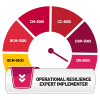Operational Resilience: Difference between revisions
No edit summary |
No edit summary |
||
| Line 29: | Line 29: | ||
{{Template:OR Course}}<br> | {{Template:OR Course}}<br> | ||
{{ORBoK 1: P1 Plan CL 1OR}}<br/> <br/> {{ORBoK 1: P1 Plan CL 1ORA}}<br/> <br/> {{BcmBoK 1 CL 1B}}<br/> <br/> {{BcmBoK 1 CL 1C}}<br/> <br/> {{BcmBoK 1 CL 1CC}}<br/> <br/> | {{ORBoK 1: P1 Plan CL 1OR}}<br/><br/> {{ORBoK 1: P1 Plan CL 1ORA}}<br/><br/> {{BcmBoK 1 CL 1B}}<br/> <br/> {{BcmBoK 1 CL 1C}}<br/> <br/> {{BcmBoK 1 CL 1CC}}<br/><br/> {{ORBoK 4: P1 Plan Confirm Risk Appetite }}<br/> | ||
{{BcmBoK 1 CL 1D}} | {{BcmBoK 1 CL 1D}} | ||
{{Bcm Institute Source}} | {{Bcm Institute Source}} | ||
Revision as of 14:15, 8 September 2024
1. Operational Resilience is the capability to absorb a shock to operations to incremental change to the disruptive events and then rebound to a level of operations acceptable to management, employees and stakeholders.

Operational Resilience: Notes (1): requires an organization to look at risk through a service perspective rather than the current practice, which focuses on management by risk category. Notes (2): includes the resilience of systems, processes and people. Notes (3): focuses more on actual business processes, such as an entire dealing service (and not only Treasury) for the bank or the assembly line the organization uses to prepare its work product. Notes (4): is a necessary component of organizational resilience. Notes (5): is an outcome that benefits from the effective operational risk management. Notes (6): has the end goal of a properly designed and implemented resilience program Notes (7): is not about reacting to one-time disruption or rebounding from a setback Notes (8): is a holistic shift in how an organization operates. 
| ||||||||||||||||||||||||||||||||||||||||||||||||||

